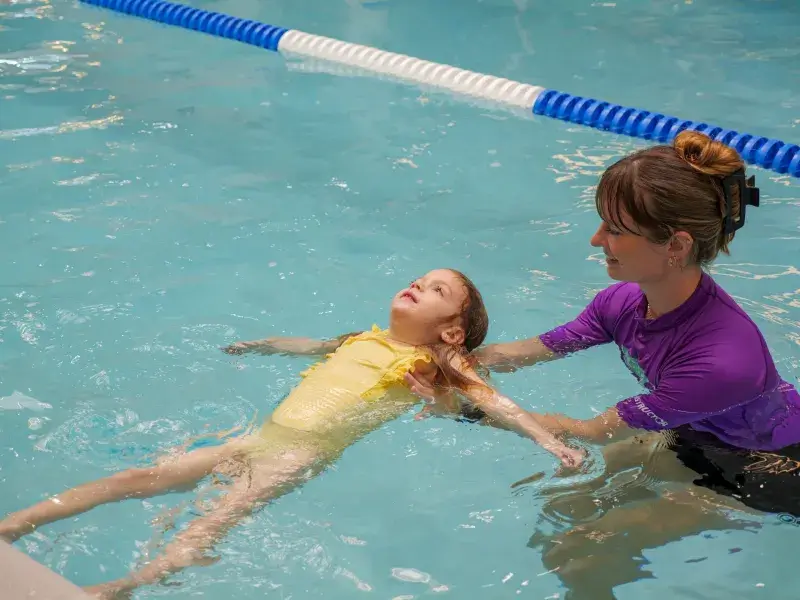Liz Huber was in a hotel pool having fun with her 20-month-old daughter — throwing her up in the air, letting her plunge under the water and pulling her back up — when a hotel employee politely chided her.
“I was a little put off by what he said,” Huber said, “but what he told me changed my life.”
The employee, who turned out to be the hotel chef, explained that his daughter was about the same age and that he had enrolled her in a program called Infant Swimming Resource or ISR. In that program, he told her, his two-year-old was taught how to roll over in the water onto her back and float if she fell in the water.
He explained that what Huber was doing put the child in danger, because in having fun she was deceived into thinking that she could fall into the water and without her mother’s assistance pop up and be ok.
Huber later learned that drowning is the leading cause of death for children one to four years old, a statistic confirmed by the CDC.
Eventually, Huber quit her job as a teacher in Oak Park and spent hundreds of hours of in-water and academic training to work with infants and toddlers in the pool, while studying topics as varied as behavioral psychology, physiology and anatomy.
She founded CAST in 2018 and used pools in the area for teaching until she opened her own facility with a pool at 7628 Madison St. in 2020.
She explained that the extensive training is essential, partly because she works with children as young as six months old who are nonverbal, and because even when working with kids who can talk, the self-rescue lesson uses sensor motor learning instead of talking.
“This curriculum is completely nonverbal,” she said, “which works well with the many kids we teach who have autism. Kids on that spectrum are 160 times more likely to drown than kids who aren’t.”
Anna Biggins, who has been with CAST since 2019, said the process runs every day for 10 minutes a day for six weeks.
She acknowledged that when parents come in and learn how committed they have to be, they often react by saying, “Whoa, every day for six weeks?”
“But then,” she said, “midway through the course they are like ‘this is incredible’, and by the end, they are asking what they can do next. When they come here every day, they get to see not only the skills their children are acquiring but the community with other parents that is created.”
“On day one,” Huber said, “Our instructors establish rapport with the parents, talk about poolside routines and discuss the child’s safety. In the water, the first thing is to establish breath control and make sure children are not swallowing water when they go under.
“Once we have established breath control, we work on head orientation and body posture and work on rolling over into a back float. We then teach a sequence of resting on the back, swimming a little, rolling onto the back and resting, swimming, etc. until the child reaches the edge of the pool.”
The children are not taught traditional swimming as most of us know it. Instead, they learn to put that their face is in the water, to maintain a horizontal body posture, and to use their arms and legs to move through the water. They do not learn class freestyle or other strokes until they’re about five.
Typically, the children whimper and cry for the first session or two, and the instructors have to assure parents that this is normal. Instructors tell parents, “I know he is screaming at you and pulling on your heartstrings, but I have to tell you that he’s not gripping me tightly anymore when we practice, he’s leaning into it, his body is calm and he is giving me sweet little hugs.”
What the crying reveals, Huber said, is not trauma or fear, but simply hard work.
“They cry for two to four days,” she said, “because they’ve been handed by a parent to a stranger, and even though the water temperature is 88 degrees, it is still not 98.6.”
“We are also making them do things they’ve never done before,” she explained. “They don’t like doing hard things that they’ve never done before. Up till now, they are babies who have experienced nothing but being loved, snuggled and coddled. What they are expressing is anger more than fear, anger that I don’t want to be doing this. What I want is to be back in the comfort of my parent’s arms.
After a week or so, the kids transition from anger to a kind of satisfaction at acquiring a new skill, and competence or even independence.
CAST is a non-profit organization, although there is no board of directors because they are privately funded, she said, mainly by the Lavin Family Foundation.
CAST has trained 12 instructors and is cooperating with the University of Alabama, Birmingham’s Youth Safety Lab on a study of water competency.
Review readers are welcome to schedule a time to observe a self-rescue swim lesson. Contact Liz Huber at liz@castwatersafety.org for information.

